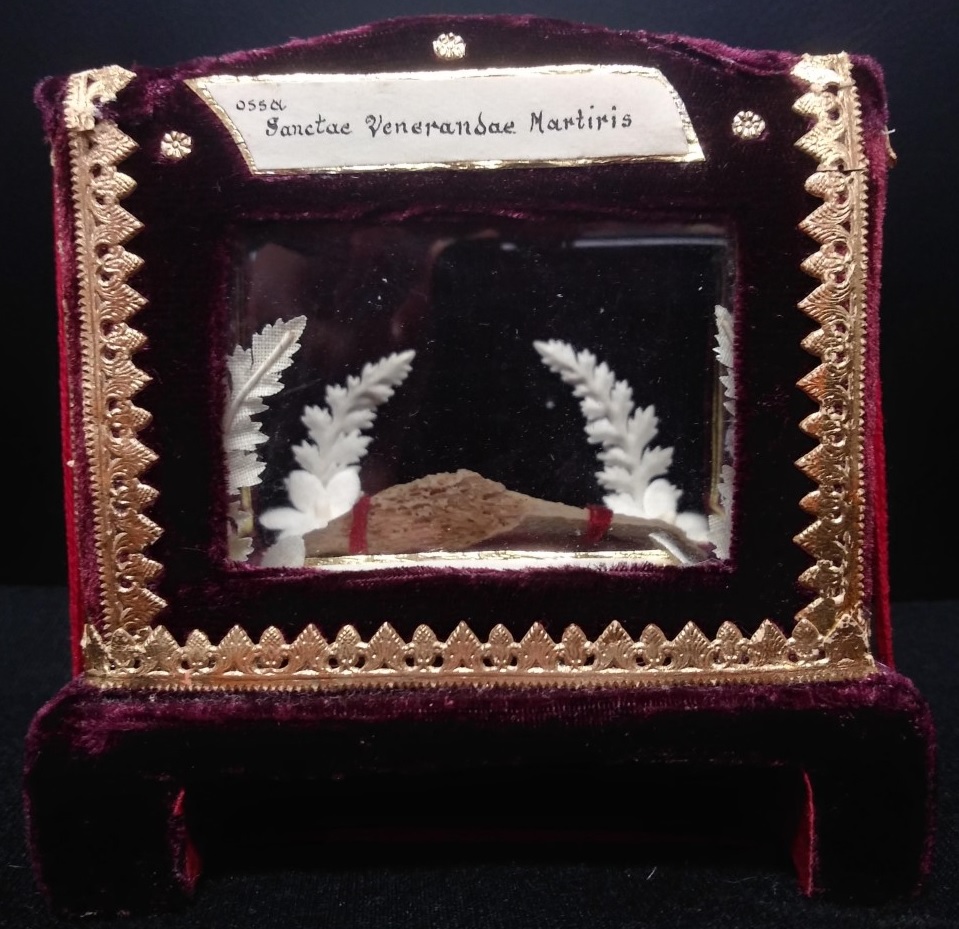
Pictured is the relic and reliquary of St. Veneranda. The inscription on the reliquary reads “Sanctae Venerandae Martiris,” translated “St. Veneranda Martyr.” COURTESY OF ARCHIVES
The most remarkable relic in the Diocese of Owensboro’s Archives
BY EDWARD WILSON, ARCHIVES
An earthly remnant of a heavenly destiny, relics, perhaps more than any other item in the Catholic Church, allow the faithful to connect with those holy souls that came before us. They also command a great deal of interest. So, with November being the month that the Church dedicates to those souls passed, an article about one of our relics seems appropriate.
Often, when we think about or see a relic, it is relatively small in size. Usually contained in a reliquary about the size of a quarter, the relic is frequently a very, very small piece of a saint’s mortal remains. The size does not detract from the significance of the relic or its otherworldly sacred presence, but they are often not large enough to be recognized as remnants of a body. That is not the case with this relic. It is roughly 3 inches in length. It is contained in a reliquary that is 4-inch by 4-inch by 4-inch and is lined in purple velvet with ornate golden trim and accents. The webbing of off-white human biological material throughout the relic makes it quite apparent that this is a piece of bone. This relic is a piece of a foot bone of St. Veneranda, or St. Venera. St. Veneranda was a martyr of the early Church. Little is known about her. However, the book of “Roman Martyrology” states that “… in France, the holy virgin Veneranda… received the crown of Martyrdom under the emperor Antoninus and the governor Asclepiades.” She lived in the early half of the second century. It is said that she was martyred in 143 AD. The account of her martyrdom under the reign of Emperor Antoninus Pius gives this date further credence.
So, how did this treasure come into the possession of the Diocese of Owensboro’s Archives? Based on clues surrounding the relic and some tracking, we now know the answer to this question. The relic was acquired in Italy by Bishop Ivo Benedetti. Bishop Benedetti brought it with him to the United States where, decades before in Pennsylvania, his sister, Mother Teresa (not to be confused with St. Teresa of Calcutta) along with four other Passionist nuns had established the first monastery of Passionist nuns in the United States. It appears that on this trip to the U.S., Bishop Benedetti visited the Passionists nuns in Owensboro and gifted them the relic. Being that their monastery had only been established a few years prior, it must have been a very joyous occasion. This was before they moved to their current location in Whitesville. It was likely given to the diocese’s Archives to avoid damage as a result of the move, or simply because St. Veneranda was not a saint of the Passionist order. Whatever the reasoning, we are now honored to be entrusted with its care.
I would like to send an enormous thank you to Mother John Mary of the Passionist Nuns of St. Joseph Monastery, in Whitesville, for her assistance and proper history lesson of Passionist nuns in the United States.
Edward Wilson is the director of the Diocese of Owensboro’s Archives and the Archives of the Ursuline Sisters of Mount Saint Joseph. Comments and questions may be sent to [email protected].
Originally printed in the November 2020 issue of The Western Kentucky Catholic.

